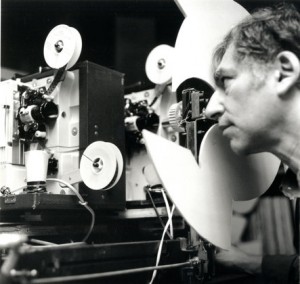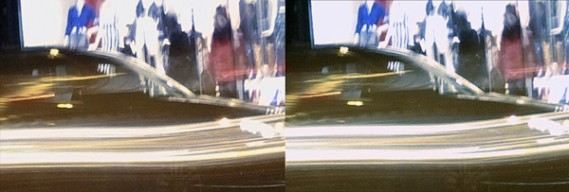Ken Jacobs, A Pioneer of American Experimental Cinema

Ken Jacobs will premiere two new films supported by Creative Capital in Carte Blanche: Ken Jacobs at The Museum of Modern Art in New York, May 2–5. The exhibition, commemorating the 80th birthday of this pioneer of American experimental cinema, includes films chosen by Jacobs from MoMA’s collection alongside selections of his own work. You can browse the Carte Blanche screening schedule and read film notes by Jacobs on the MoMA website.

After more than 50 years as a filmmaker, Jacobs remains as innovative and productive as ever. The two films premiering in Carte Blanche: Ken Jacobs, entitled Joys of Waiting for the Broadway Bus and A Primer in Sky Socialism, both represent Jacobs’ current exploration of digital 3-D filmmaking. Joys of Waiting for the Broadway Bus was shot by Jacobs over the course of several bus rides in his New York City neighborhood. Jacobs writes, “Since acquiring a small 3-D camera, I dawdle everywhere, but prolonged bus-waits allow for a continuity of images, and thus a movie.” Ken presents each 3-D still onscreen for 6 to 8 seconds, instead of the usual rapid turnover used to create the illusion of movement. The result is a dense optical event that will be presented in four 40-minute parts as the close to each day’s screenings at MoMA.
Ken Jacobs, still from Joys of Waiting for the Broadway Bus
The second film supported by Creative Capital, A Primer in Sky Socialism, is a tribute to the Brooklyn Bridge and the idealism of the Roebling family, who designed the bridge. Jacobs, who was born in Brooklyn and is a life-long New Yorker, writes, “The Bridge has been particularly dear to [my wife Flo and me] since the ‘60s, when we learned the story of the Roeblings, father and son and daughter-in-law. The Bridge embodies their wishes for America, their blessing—nothing less.”
I recently connected with Ken to learn more about his long and influential career as a filmmaker and what other projects he has in the works.
Jenny Gill: As a native New Yorker, what does it mean to have a major film program like this presented at The Museum of Modern Art?
Ken Jacobs: It’s fulfilling, of course. As a student in Brooklyn, a teacher gave me a free pass to MoMA, and that’s where I saw modern art and world cinema for the first time. I’ve come through as a filmmaker, having convinced myself that my sort of movie is a form of painting, that it would not have happened without looking at paintings as a young visitor to MoMA, or then studying with Hans Hofmann and my admiration for the Abstract Expressionists. Like the paintings I still admire, my films can excite some individuals but can’t make any difference in the world—for one thing, because of the learning/sensitizing demands they make on viewers—adapt to a movie? who does that?—but then neither can Michael Moore. Ladies and gentlemen, the Titanic is being piloted by drunks. Other than my art, my ambition to redesign our environment—with buildings that lift the ground closer to the sky, still covered with grass and trees and where kids can still play—will remain on hold.
Jenny: You’ve been making experimental films now for over 50 years. What was the first film you ever made, and what inspired you to make it?
Ken: I was filming the Third Avenue elevated train when Cinema 16 showed an entire program picturing the El, including Stan Brakhage’s The Wonder Ring. I then switched to recording Orchard Street, which at that time was the very Jewish outdoor marketplace on the Lower East Side. What we call the Holocaust had just happened, and I was working at grasping it. I moved to a tiny apartment on Ludlow Street to save on carfare and filmed in 16mm for a year, 1954-55, through the seasons. Nice film, in MoMA’s collection, but when it failed to relieve my poverty or open prospects for filming my epic screenplay, Variation on a Theme, I was ready to star Jack Smith and Jerry Sims in the 440 minute Star Spangled to Death. And could only afford to finish that as digital video in 2002.

Ken Jacobs, still from A Primer in Sky Socialism
Jenny: Your work has taken so many forms over the years, and you’re always experimenting. What do you think the quintessential Ken Jacobs film is, if you had to pick one?
Ken: I fall in love continually. A walk through the streets means numberless phantom-marriages, other than this wonderfully enduring one with Flo. Similarly, each film is premised on a sort of toy-for-the-mind that fascinates me and each seems to me quintessential. There’s a hopeless work as crowd-pleaser, a cinematic eye-chart called Brain Operations (2009, 22 min), which is a good example of what can be done when living on retirement money while resigned to being peripheral. 3-D via crossed eyes, no less.
Jenny: How did you approach curating a group of films from MoMA’s collection to pair with your own work?
Ken: The selected films were among the earliest I chanced upon as a kid “going to college” at MoMA. There’s Vigo’s Zero For Conduct, but not Stroheim’s Greed, to make it obvious to anyone who knows me that this is a near-arbitrary selection up against the limitations of a schedule. What? No Trouble in Paradise or Love Me Tonight? No Freaks? No Chaplin or Keaton, no Russian geniuses? And then I include Island of Lost Souls, which I came upon after my MoMA education and when I was myself teaching in Binghamton, if only to indicate my promiscuousness as a film-lover.
Jenny: What else are you working on right now?
Ken: I am writing this at one computer as another is processing the four-part, 170-minute, 3-D Joys of Waiting for the Broadway Bus in preparation for the lab, so it can be shown next week. We’re awaiting the return of A Primer In Sky Socialism from Chicago, where Mark Downie of the OpenEndedGroup (three 3-D cine-geniuses) prepared it for the MoMA screening (which will have live accompaniment by Michael Schumacher’s band, diNMachine). The Aiptek 3-D videocamera—very cheap despite coming here all the way from China—records, in the right shaky hands, astonishing night-shots. Truth is: Flo did the waiting while I grabbed images left and right. The Hofmann classes alerted me to depth, and when my deviation into cinema made illusionary-depth possible, despite the Hofmann injunction to not make “holes,” there was no turning back. Joys and A Primer were done on the Creative Capital tab, and who knows what incomparably greater Destructive Capital might now sponsor.
Carte Blanche: Ken Jacobs runs at The Museum of Modern Art May 2-5, 2013.

